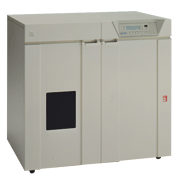The F6765N, announced in February 1992, was Fujitsu’s first continuous-form page printer to support its new JEF/AP* print system. The new printer featured revamped functions and designs based on experiences with the previous F6715E model, faster print speeds, improved operator convenience, and less labor.
- Features of the F6765N:
- (1) Support for the JEF/AP print system
- (2) Improvements to the print process speed and transport efficiency allowed the F6765N to print 25 percent faster than the previous F6715E model
- (3) Took up 25 percent less installation space because of improvements to structural components
- (4) Autoloader made paper exchanging easier and saved operators time
*JEF/AP: Japanese processing Extended Feature / Advanced Printing. By adding outline fonts and per-page control of print parameters to the JEF Japanese-language processing functions, Fujitsu created a print system with much more creative flexibility.
| Model name | F6765N | |
|---|---|---|
| Introduced | February 1992 | |
| Print process | Laser xerographic process | |
| Fixing method | Flash fixing | |
| Print speeds | 12 lines/inch | 5,000 lines/min. |
| 8 lines/inch | 3,300 lines/min. | |
| 6 lines/inch | 2,500 lines/min. | |
| Resolution | 240×240 dpi | |
| Print modes | Line printer mode / page printer mode | |
| Primary host models | FUJITSU M series | |
| Character types | Alphanumeric, kana, kanji (using outline fonts) |
|---|---|
| Character spacing | User definable |
| Line spacing | User definable |
| Alignment | Able to align any media (text, graphics, images) at any position |
| Character sizes | 3〜300 point |
| Character rotation | User definable |
| Text orientation | Able to specify up, down, left, or right |
| Format printing | Format overlay (vector overlay method) |
| Graphics printing | Line segments, circles, arcs, area fill, etc. (ISO / CGM compliant) |
| Image printing (optional) |
|
| Barcode printing | Supported NW7, JAN, Code 3 of 9, 2 of 5, courier formats, and UPC barcodes (able to print either vertically or horizontally) |


